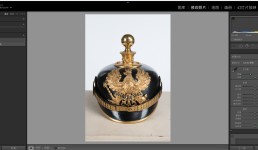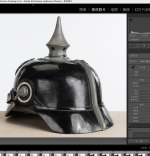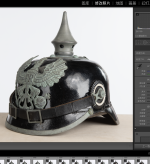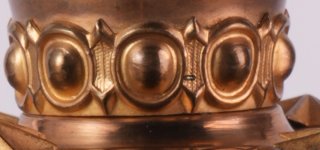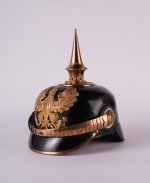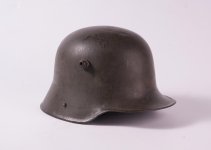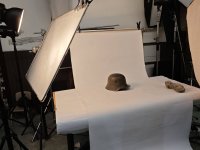Sandmann
Well-known member
Dear fellow forum members,
I'd like to share my experiences in photographing pickelhauben and initiate an exchange of experiences on this topic. I hope we can learn from each other as I've seen a lot of great photos from some of you here on the forum and I wish I could learn more about proper lighting for studio photography. My goal is to take a nice photo of a helmet that doesn't need any post-processing. For less reflective helmets, this issue is certainly not that important, but this helmet, for example, has a very shiny surface and was therefore quite challenging. To achieve my goal, I read and tested a lot to find a method of illuminating the helmet well all around while avoiding annoying reflections from the light sources on the helmet surface. (Please overlook the partially untidy image sections, as these are just test photos to check the lighting. For the final photos I would like to wait for this post)- I started with indirect lighting on a white curved reflector (used lights: Rollei Soluna II-60 with 100% output). My idea was to avoid the typical reflections of 2 light sources on the surface, the light should look like ambient daylight. However, the illumination from the reflected light wasn’t sufficient and the helmet visors were unfortunately not illuminated well enough.
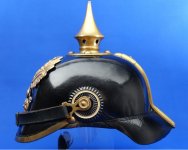
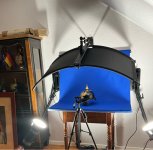
- For the next try I used a 110 cm x 110 cm diffuser flag panel, which was placed a little above the helmet. In various guides on photographing very reflective objects, it was said that you should place a large white surface over the object so that this is as far as possible the only thing that is reflected on the object's surface. The light came from a 60cm x 90cm softbox positioned from above and slightly forward. The reflection from the diffuser flag on the helmet looks a little better to me, but unfortunately the helmet visors were still too dark.
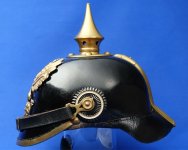 View attachment 46113
View attachment 46113I therefore had to think about how I could use a front light on the helmet without the disturbing reflections of the softboxes on it.
- For this I tried a Light Cone (size L), which I placed horizontally around the helmet (open at the bottom). This was illuminated by my lights with 50% output and equipped with 2 softboxes 60 cm x 90 cm, that were positioned at the front left and front right, a little bit higher than the Camera. In my opinion this set up led to the best result, as the helmet is beautifully illuminated nearly everywhere and there are no annoying reflections from the room. The only small disadvantage is the slightly matted surface of the helmet, which was caused by the solid white surface of the light cone reflecting on it. To eliminate the disturbing reflections of the Light Cone in the glass, I decided to use a wooden helmet stand for future photos, with a surface that doesn't reflect the environment so much. However, there are no annoying reflections from the softboxes on the helmet and it looks as if only one light source was used. It is an extremely soft light created as a result of the two diffusion layers of the softboxes and the Light Cone.
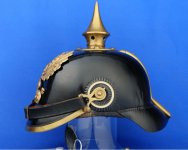
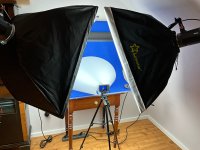
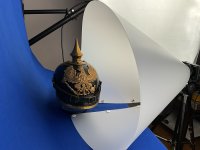 View attachment 46112
View attachment 46112Hopefully my experiences will help you with an attractive helmet photography. I would be glad if you would also share your experiences in photographing helmets or other military objects with us.
Thank you very much in advance, I look forward to your tips and experiences.

